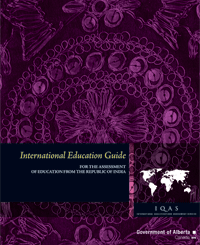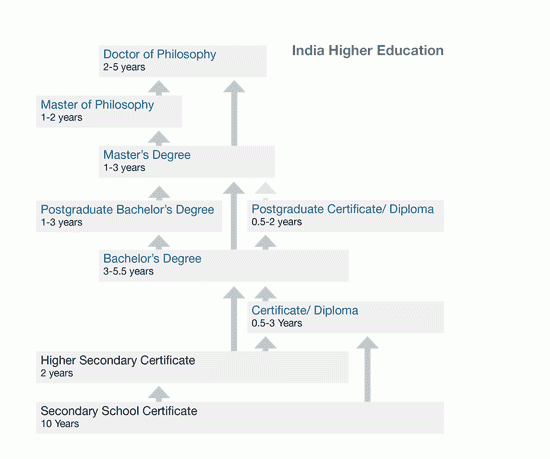Download guide

This is not an official IQAS assessment. The recommendations in this guide are for your information only. These credential comparisons represent common educational patterns within each country. They do not take into account the recognition status of the institution through which a credential was obtained, the authenticity of the documentation, or the particular pattern of education followed by an individual.
Country overview
Official country name: Republic of India
Location: South Asia
Capital: New Delhi
Area: 3.3 million square km
Population: 1.1 billion
Ethnicity: The people of India have great ethnic, cultural and linguistic diversity. The population is 72% Indo-Aryan, 25% Dravidian, and 3% Mongoloid and others.
Religion: Religion plays an important role in India, where Hinduism, Buddhism and Jainism originated. The major religions include Hinduism (81.4%), Islam (12.4%) and Christianity (2.3%).
Languages: Hindi is the official language and the most commonly spoken. English also has official status as an “associate language” and is widely used in business and politics. In most of the country, both Hindi and English are taught in schools. English is the language of instruction for most programs in higher education.
Founding Date: India became a British colony in the 18th century and gained independence on August 15, 1947, when the Indian subcontinent was divided into India and Pakistan (comprising present-day Pakistan and Bangladesh).
Administration: India is a federal republic and the world’s largest democracy in terms of population. It has 28 states and 7 union territories.
School education

India’s 12-year school system evolved in the 1970s and has been fully implemented across the country since the late 1980s. In most states, it consists of 8 years of elementary education, 2 years of secondary education, and 2 years of higher secondary or pre-university education.
Students in Class 10 and Class 12 must sit external examinations administered by a state board or 1 of the 3 all-India boards to receive their exit credentials, whose actual names vary by examining board and time period. The credential representing the completion of secondary education is usually called Secondary School Certificate or Matriculation Examination Certificate. The credential representing the completion of higher secondary education is usually called Higher Secondary Certificate, Senior School Certificate, or Intermediate Examination Certificate. The completion of higher secondary education gives access to university study.
Higher education overview

Higher education in India follows the 3-tier degree structure – bachelor’s, master’s and doctoral-level studies. In addition, certificate and diploma programs are offered at both undergraduate and graduate levels.
General bachelor’s degrees, such as Bachelor of Arts, Bachelor of Science and Bachelor of Commerce, involve 3 years of fulltime study. Professional bachelor’s degrees in specialized fields such as agriculture, engineering and technology, law, medicine, dentistry and pharmacy take between 4 and 5-and-a-half years to complete.
Bachelor’s degrees in a few specialized fields such as education and library science require the completion of a previous bachelor’s degree for admission. These are called postgraduate bachelor’s degrees.
Master’s degrees normally take 2 years to complete and can be either research or coursework based.
Master of Philosophy (MPhil) programs take 1 to 2 years after the completion of a master’s degree, often as a preparatory program for doctoral studies.
Doctoral degree (PhD) programs vary but normally take at least 2 years after an MPhil or 3 or more years after a master’s degree.
Technical education
Diploma courses in various technical fields last 2 to 3 years following the completion of Class 10 or Class 12. A diploma in engineering and technology requires 3 years of study after Class 10 or 12, depending on the state requirements. Diploma programs in pharmacy and library science are 2 years beyond Class 12. Diplomas in other technical fields typically require 2 to 2-and-a-half years after Class 10.
Institutions
Four major types of universities and university-level institutions are authorized to award academic degrees in India: universities, deemed universities, institutions of national importance (which include the famous Indian Institutes of Technology) and research institutions outside the university system.
The University Grants Commission advises the federal and state governments on the recognition and approval of degree-awarding institutions, and its website provides lists of recognized higher education institutions. The All-India Council for Technical Education is responsible for approving technical institutions.
Credentials comparison
| Credential | Entrance requirements | Length of study | IQAS comparison |
|---|---|---|---|
| Secondary School Certificate | Completion of Elementary and Upper Primary School (8 years) | 2 years | Generally compares to the completion of Grade 10. |
| Higher Secondary School Certificate | Secondary School Certificate (10 years) | 2 years | Generally compares to the completion of a High School Diploma. |
| University-level certificates and diplomas | Admission requirements vary | 2 to 3 years | Generally compares to completion of post-secondary certificate or diploma, depending on admission requirements. |
| Technical-Professional Diploma (2 to 3-year program following the Higher Secondary School Certificate) | Higher Secondary School Certificate (12 years) | 2 to 3 years | Generally compares to the completion of a post-secondary Diploma. |
| Technical-Professional Diploma (Minimum 3 year program following the Secondary School Certificate) | Secondary School Certificate (10 years) | 3 years (minimum) | Generally compares to the completion of a post-secondary Certificate. |
| Technical-Professional Diploma (Maximum 2 year program following the Secondary School Certificate program) | Secondary School Certificate (10 years) | 2 years or less | Generally compares to the completion of a High School Diploma, including vocational training. |
| Diploma in Pharmacy (2-year program following the Secondary School Certificate) | Secondary School Certificate (10 years) | 2 years | Generally compares to the completion of a post-secondary Pharmacy Technician Certificate. Note: Awarded prior to 1994. |
| Diploma in Pharmacy (2-year program following the Higher Secondary School Certificate) | Higher Secondary School Certificate (12 years) | 2 years | Generally compares to the completion of a post-secondary Pharmacy Technician Diploma. Note: Awarded in or after 1994. |
| Diploma in Homeopathic Medicine and Surgery | Higher Secondary School Certificate (12 years) | 4 years | Generally compares to the completion of a 3-year post-secondary Diploma with a focus in Homeopathic medicine. |
| Bachelor’s degree (3-year program) | Higher Secondary School Certificate (12 years) | 3 years | Generally compares to the completion of a 3-year Bachelor’s degree. |
| Bachelor’s degree (4-year program) | Higher Secondary School Certificate (12 years) | 4 years | Generally compares to the completion of a 4-year Bachelor’s degree. |
| Bachelor of Medicine and Bachelor of Surgery | Higher Secondary School Certificate (12 years) | 5.5 years | Generally compares to the completion of a first professional university degree in medicine. |
| Bachelor of Ayurvedic Medicine and Surgery | Higher Secondary School Certificate (12 years) | 5.5 years | Generally compares to the completion of a Bachelor’s degree with a focus in Ayurvedic medicine. |
| Bachelor of Homeopathic Medicine and Surgery | Higher Secondary School Certificate (12 years) | 5.5 years | Generally compares to the completion of a Bachelor’s degree with a focus in homeopathic medicine. |
| Bachelor of Homeopathic Medicine and Surgery Graded Degree | Diploma in Homeopathic Medicine and Surgery | 2 years | Generally compares to the completion of a Bachelor’s degree with a focus in homeopathic medicine. |
| Bachelor of Dental Surgery | Higher Secondary School Certificate (12 years) | 5 years | Generally compares to the completion of a first professional university degree in dentistry. |
| Bachelor of Veterinary Medicine and Animal Husbandry | Higher Secondary School Certificate (12 years) | 5 years | Generally compares to the completion of a first professional university degree in veterinary medicine. |
| Bachelor of Laws (Special / Professional) | 3-year Bachelor’s degree | 3 years | Generally compares to the completion of a first professional university degree in law. |
| Bachelor of Laws (General / Academic) | 3-year Bachelor’s degree | 2 years | Generally compares to the completion of a 2-year Bachelor’s after-degree with a focus in law. |
| Bachelor of Laws (Integrated program) | Higher Secondary School Certificate (12 years) | 5 years | Generally compares to the completion of a first professional university degree in law. |
| Bachelor of Education (1-year program) | 3-year Bachelor’s degree | 1 year | Generally compares to the completion of a 1-year Bachelor of Education after-degree. |
| Bachelor of Education (2-year program) | 3-year Bachelor’s degree | 2 year | Generally compares to the completion of a 2-year Bachelor of Education after-degree. |
| Bachelor of Education (4-year program) | Higher Secondary School Certificate | 4 years | Generally compares to the completion of a 4-year Bachelor of Education degree. |
| Bachelor of Education | 1 year | ||
| Master of Education (pre-2015) | 3-year Bachelor’s degree | 2 years | Generally compares to the completion of a Master’s degree with a focus in education. |
| Master of Education (2015-) | Bachelor of Education (1-year, 2-year, or 4-year program) or Diploma in (Elementary) Education plus a 3-year Bachelor’s degree | 2 years | Generally compares to the completion of a Master’s degree with a focus in education. |
| Master’s degree (2-year program following a 3-year Bachelor’s degree) | 3-year Bachelor’s degree | 2 years | Generally compares to the completion of a Master’s degree. |
| Master’s degree (2-year program following a 4-year Bachelor’s degree) | 4-year Bachelor’s degree | 2 years | Generally compares to the completion of a Master’s degree. |
| Master of Business Administration and Executive Master of Business Administration | 3-year Bachelor’s degree | 2 years | Generally compares to the completion of a Master of Business Administration (MBA) degree or Executive Master of Business Administration (EMBA) degree. |
| Post-graduate Certificate or Diploma from university-level institutions or institutions with appropriate program accreditation (such as AICTE) | 3 or 4-year Bachelor’s degree | 0.5 to 2 years | Generally compares to the completion of a Graduate, Certificate or Diploma. (Shorter programs are generally compared to certificates while longer programs can be compared to diplomas.) |
| Master of Philosophy | Master’s degree | 1 to 2 years | Generally compares to the completion of a Master’s degree. |
| Doctor of Philosophy | Master’s degree | 3 years (minimum) | Generally compares to the completion of a Doctor of Philosophy (PhD) degree. |
Full credential templates
These templates give detailed information on educational credentials awarded for programs of study completed in the Republic of India
These templates include:
- official name of credential
- alternative names
- standardized English translation (if applicable)
- time period the credential was offered
- issuing body, admission requirements into the program
- descriptive program information
- recommendations on how the credential compares to educational standards in Alberta
Republic of India - credential templates
Additional resources
Government of India, Ministry of Human Resource Development
Central Board of Secondary Education
Council for the Indian School Certificate Examinations
National Institute of Open Schooling
All-India Council for Technical Education
UNESCO International Bureau of Education, World data on education: India